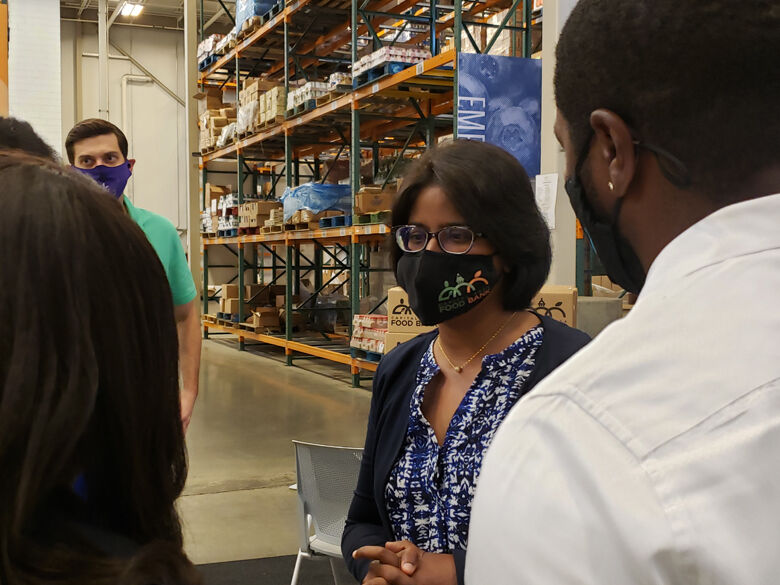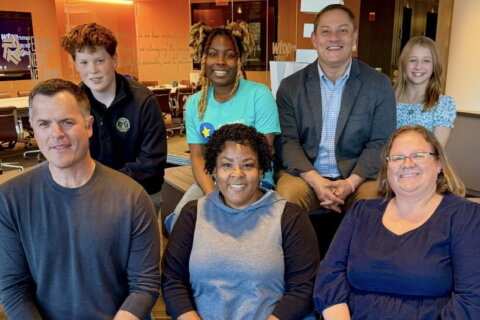
More families in Virginia and Maryland, and significantly more Latino families, were pushed into food insecurity during the COVID-19 pandemic, according to a new report on hunger in the D.C. area, which a nonprofit official called a “dramatic shift in the face of hunger.”
The Hunger Report 2021, published Thursday by the Capital Area Food Bank, is based on surveys with nearly 2,000 people who had visited the food bank’s food distribution sites over the past year, providing “ground-level insights into the impact of the pandemic on our neighbors’ lives.”
Overall, two-thirds of respondents in the survey said they had visited a food pantry for the first time in the last year, with nearly 90% saying their need for free food was a direct result of the COVID-19 pandemic.
Using the survey data, the report contrasts the newly food-insecure with those who were food-insecure before the pandemic.
The report found those newly experiencing food insecurity were more likely to be Latino, to live in larger households with more children and to have lower English-language proficiency.
In addition, those newly struggling with food insecurity were more likely to be employed — and less likely to be enrolled in government assistance programs.
“Looking back this past year, we know that the pandemic has not impacted our neighbors evenly across the country,” Capital Area Food Bank CEO Radha Muthiah said during a news conference to unveil the report at the food bank’s warehouse in Northeast D.C.
According to the report, Latino people made up just 16% of people considered food insecure before the pandemic but 51% during the pandemic, according to the report. Among the newly food-insecure, 69% have children compared to 43% of people who struggled with food insecurity before the pandemic. In addition, 66% of the newly hungry are working to compared to 39% pre-pandemic.
Food insecurity is defined by the USDA as “a lack of consistent access to enough food for an active, healthy life.”
Call to action
At the news conference, federal and state lawmakers urged swift and significant government action on addressing hunger, saying policymakers have a unique opportunity to address hunger as the COVID-19 pandemic eases.
Rep. Jim McGovern (D-Mass.), who chairs the House Rules Committee and the “House Hunger caucus,” said it’s not time for “victory laps” — that even as life return to a pre-pandemic rhythm, the report shows the depth of the problem, especially for children.
“I’ve been hearing a lot of talk about returning to normal,” McGovern said. “Everywhere I go people say, ‘I can’t wait to get back to normal.’ Let me say this — I don’t want to return to normal. Normal is not good enough. Normal means living in a country where roughly 35 million Americans go hungry, including 10 million children who have no idea where their next meal is coming from. If you’ve ever met a hungry child, it breaks your heart.”
The congressman said he would introduce a bill co-sponsored by New Jersey Democratic Sen. Cory Booker calling on the White House to hold a national conference on food and hunger in the U.S. to bring together government policymakers, business leaders, the nonprofit community and “real people discussing their everyday, lived experience with hunger.”
He added, “Some have been content to sleepwalk through this crisis, but it’s time to wake the hell up.”
Closing gaps in SNAP, other government programs
Among the recommendations for reducing food insecurity is improving access to government support programs. The survey found fewer than one in four of the newly food insecure were receiving SNAP benefits, the program formerly known as food stamps. Only one in five receive free and reduced lunches, according to the report.
Muthiah called on local governments to take steps to close the significant gaps between those eligible for government programs, such as SNAP, and those actually enrolled.
In Fairfax County, for example, an estimated 91,000 people are eligible for the SNAP program, according to the report, but fewer than 40,000 people are enrolled. In Montgomery County, there are more than 96,000 eligible but fewer than 58,000 participating.
Maryland Del. Lorig Charkoudian said the report underscores “just how many people live so close to the edge even in so-called normal times.”
She called for broad changes to economic structures that exploit low-wage workers, “who are then dependent on piecing the scraps together to make it through.”
And she said government “has done an abysmal job at making all of the various programs that we have accessible to people who need them.”
She added: “We’ve got to get it right. And if this isn’t the call to action, if this isn’t the time to straighten that out, I don’t know if we’re ever going to get it right. If we can’t see it now, I don’t know when we’ll see it. “








